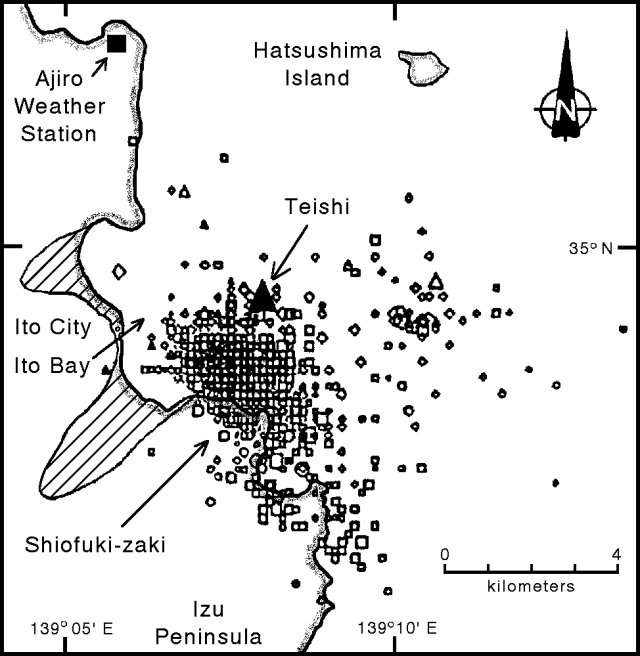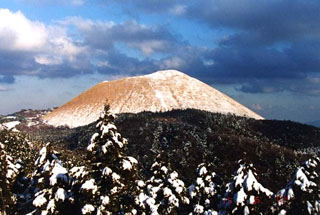Report on Izu-Tobu (Japan) — May 1993
Bulletin of the Global Volcanism Network, vol. 18, no. 5 (May 1993)
Managing Editor: Edward Venzke.
Izu-Tobu (Japan) Strongest earthquake swarm since 1989 submarine eruption
Please cite this report as:
Global Volcanism Program, 1993. Report on Izu-Tobu (Japan) (Venzke, E., ed.). Bulletin of the Global Volcanism Network, 18:5. Smithsonian Institution. https://doi.org/10.5479/si.GVP.BGVN199305-283010
Izu-Tobu
Japan
34.9°N, 139.098°E; summit elev. 1406 m
All times are local (unless otherwise noted)
The strongest earthquake swarm since the 1989 submarine eruption at Teishi Knoll occurred between 28 May and 8 June, with no accompanying volcanic activity. Sources were located around Shiofuki-zaki cape, Ito City, on the E coast of the Izu Peninsula (figure 13). The source area, centered 2 km S of Teishi Knoll, roughly covers the S margin of the 1989 area. Focal depths were at 5-8 km, deeper than the 1-5 km depths in 1989. The seismicity consisted of short-period tectonic-type activity and low-frequency events. Volcanic tremor was not recorded.
 |
Figure 13. Epicenters of earthquakes in the Izu-Tobu area, 26 May-7 June 1993. Hatched area shows most densely inhabited area in Ito City. Courtesy of JMA. |
A total of 9,500 shocks was recorded in Ito City at a seismic station 5 km SW of the source; 25,000 events were recorded in 1989. Personnel at Ajiro Weather Station, 9 km NNW of the source, felt 175 shocks, the strongest of which reached intensity IV on the JMA scale. The largest shock was M 4.3 at 1512 on 31 May, compared to M 5.5 in 1989. No direct damage was caused by the seismicity, but hotels in Ito, a popular spa resort area, lost a reported 1.2 billion yen (> $11 million U.S.) after 60,000 tourists canceled their stay.
Frequent EDM and GPS measurements showed rapid expansion of up to 4 cm over Ito Bay from 27 May to 3 June when seismicity was high. Two tiltmeters near the coast of Ito showed a rapid decline (down tilt to the E) and a borehole strainmeter 20 km S of the source recorded rapid contraction during the same period. Ground deformation was [20-50%] that recorded in 1989. The deformation data are interpreted by JMA as suggesting an opening underground beneath the bay at a few kilometers depth.
Geological Summary. The Izu-Tobu volcano group (Higashi-Izu volcano group) is scattered over a broad, plateau-like area of more than 400 km2 on the E side of the Izu Peninsula. Construction of several stratovolcanoes continued throughout much of the Pleistocene and overlapped with growth of smaller monogenetic volcanoes beginning about 300,000 years ago. About 70 subaerial monogenetic volcanoes formed during the last 140,000 years, and chemically similar submarine cones are located offshore. These volcanoes are located on a basement of late-Tertiary volcanic rocks and related sediments and on the flanks of three Quaternary stratovolcanoes: Amagi, Tenshi, and Usami. Some eruptive vents are controlled by fissure systems trending NW-SE or NE-SW. Thirteen eruptive episodes have been documented during the past 32,000 years. Kawagodaira maar produced pyroclastic flows during the largest Holocene eruption about 3,000 years ago. The latest eruption occurred in 1989, when a small submarine crater was formed NE of Ito City.
Information Contacts: JMA.

